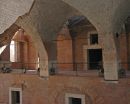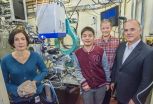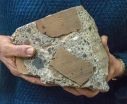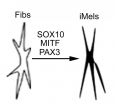(Press-News.org) No visit to Rome is complete without a visit to the Pantheon, Trajan's Markets, the Colosseum, or the other spectacular examples of ancient Roman concrete monuments that have stood the test of time and the elements for nearly two thousand years. A key discovery to understanding the longevity and endurance of Roman architectural concrete has been made by an international and interdisciplinary collaboration of researchers using beams of X-rays at the Advanced Light Source (ALS) of the U.S. Department of Energy (DOE)'s Lawrence Berkeley National Laboratory (Berkeley Lab).
Working at ALS beamline 12.3.2, a superconducting bending magnet X-ray micro-diffraction beamline, the research team studied a reproduction of Roman volcanic ash-lime mortar that had been previously subjected to fracture testing experiments at Cornell University. In the concrete walls of Trajan's Markets, constructed around 110 CE, this mortar binds cobble-sized fragments of tuff and brick. Through observing the mineralogical changes that took place in the curing of the mortar over a period of 180 days and comparing the results to 1,900 year old samples of the original, the team discovered that a crystalline binding hydrate prevents microcracks from propagating.
"The mortar resists microcracking through in situ crystallization of platy strätlingite, a durable calcium-alumino-silicate mineral that reinforces interfacial zones and the cementitious matrix," says Marie Jackson, a faculty scientist with the University of California (UC) Berkeley's Department of Civil and Environmental Engineering who led this study. "The dense intergrowths of the platy crystals obstruct crack propagation and preserve cohesion at the micron scale, which in turn enables the concrete to maintain its chemical resilience and structural integrity in a seismically active environment at the millennial scale."
Jackson, a volcanologist by training who led an earlier study at the ALS on Roman seawater concrete, is the lead author of a paper describing this study in the Proceedings of the National Academy of Sciences (PNAS) titled "Mechanical Resilience and Cementitious Processes in Imperial Roman Architectural Mortar." Co-authors of the paper are Eric Landis, Philip Brune, Massimo Vitti, Heng Chen, Qinfei Li, Martin Kunz, Hans-Rudolf Wenk, Paulo Monteiro and Anthony Ingraffea.
The mortars that bind the concrete composites used to construct the structures of Imperial Rome are of keen scientific interest not just because of their unmatched resilience and durability, but also for the environmental advantages they offer. Most modern concretes are bound by limestone-based Portland cement. Manufacturing Portland cement requires heating a mix of limestone and clay to 1,450 degrees Celsius (2,642 degrees Fahrenheit), a process that releases enough carbon - given the 19 billion tons of Portland cement used annually - to account for about seven-percent of the total amount of carbon emitted into the atmosphere each year.
Roman architectural mortar, by contrast, is a mixture of about 85-percent (by volume) volcanic ash, fresh water, and lime, which is calcined at much lower temperature than Portland cement. Coarse chunks of volcanic tuff and brick compose about 45-to-55-percent (by volume) of the concrete. The result is a significant reduction in carbon emissions.
"If we can find ways to incorporate a substantial volumetric component of volcanic rock in the production of specialty concretes, we could greatly reduce the carbon emissions associated with their production also improve their durability and mechanical resistance over time," Jackson says.
As part of their study, Jackson and her collaborators at UC Berkeley used ALS beamline 12.3.2 to make X-ray micro-diffraction measurements of slices of the Roman mortar that were only about 0.3 millimeters thick.
"We obtained X-ray diffractograms for many different points within a given cementitious microstructure," Jackson says. "This enabled us to detect changes in mineral assemblages that gave precise indications of chemical processes active over very small areas."
The mineralogical changes that Jackson and her collaborators observed showed the mortar reproduction gaining strength and toughness over 180 days as calcium-aluminum-silicate-hydrate (C-A-S-H) cementing binder coalesced and strätlingite crystals grew in interfacial zones between volcanic scoria and the mortar matrix. The toughening of these interfacial zones is reflected in the bridging crack morphology, which was measured by co-author Landis at the University of Maine, using computed tomography scans of the fractured mortar specimens. These experimental results correlate well with computations of increasing fracture energy determined by co-author Brune, now at Dupont Technologies. The strätlingite crystals show no corrosion and their smooth surfaces suggest long-term stability, similar to geological strätlingite that persists for hundreds of thousands of years.
"The in situ crystallization of the strätlingite crystals produces interfacial zones that are very different from any interfacial microstructure observed in Portland cement concretes," Jackson says. "High porosity along the interfacial zones of inert aggregates in Portland cement concrete creates the sites where crack paths first nucleate and propagate."
A future challenge for researchers, Jackson says, will be to "find ways to activate aggregates, as slag or as volcanic ash for example, in innovative concretes so that these can develop strätlingite reinforcements in interfacial zones like the Roman architectural mortars."
The fracture testing experiments at Cornell University were led by co-author Ingraffea. The samples of mortar from Trajan's Markets were provided by co-author Vitti and the Sovrintendenza Capitolina di Roma Capitale. Co-author Kunz is the principal scientist at ALS beamline 12.3.2.
INFORMATION:
This research was supported by the National Science Foundation and the Loeb Library at Harvard University. The Advanced Light Source is a DOE Office of Science User Facility.
Lawrence Berkeley National Laboratory addresses the world's most urgent scientific challenges by advancing sustainable energy, protecting human health, creating new materials, and revealing the origin and fate of the universe. Founded in 1931, Berkeley Lab's scientific expertise has been recognized with 13 Nobel prizes. The University of California manages Berkeley Lab for the U.S. Department of Energy's Office of Science. For more, visit http://www.lbl.gov.
DOE's Office of Science is the single largest supporter of basic research in the physical sciences in the United States, and is working to address some of the most pressing challenges of our time. For more information, please visit the Office of Science website at science.energy.gov/.
Researchers at the Norris Cotton Cancer Center and University of Hawaii Cancer Center find that one-third of Hawaiian adolescents have tried e-cigarettes, half of whom have never used another tobacco product.
"This is a markedly different pattern of use compared to their peers in the continental U.S., where teen e-cigarette use is less than half that rate and e-cigarette users are mainly also cigarette smokers (dual-users)," reported James D. Sargent, MD, a pediatrician at Dartmouth Hitchcock's Norris Cotton Cancer Center in a paper published December 15, 2014 in the ...
Average chloride concentrations often exceed toxic levels in many northern United States streams due to the use of salt to deice winter pavement, and the frequency of these occurrences nearly doubled in two decades.
Chloride levels increased substantially in 84 percent of urban streams analyzed, according to a U.S. Geological Survey study that began as early as 1960 at some sites and ended as late as 2011. Levels were highest during the winter, but increased during all seasons over time at the northern sites, including near Milwaukee, Wisconsin; Chicago, Illinois; Denver, ...
ATLANTA--The Paleolithic diet, or caveman diet, a weight-loss craze in which people emulate the diet of plants and animals eaten by early humans during the Stone Age, gives modern calorie-counters great freedom because those ancestral diets likely differed substantially over time and space, according to researchers at Georgia State University and Kent State University.
Their findings are published in The Quarterly Review of Biology.
"Based on evidence that's been gathered over many decades, there's very little evidence that any early hominids had very specialized diets ...
Los Angeles, CA (November 16, 2014) A new article reports that despite a clear lack of research on male survivors of Ebola, the current recommended practice of waiting at least three months after recovery to have unprotected sex should be upheld. This study was published today in Reproductive Sciences, a SAGE journal.
"Our exercise demonstrated that the current recommendations to prevent the sexual spread of Ebola are based on one mere observation," the researchers wrote. "Despite the evident need to conduct more research, for now, health care professionals should strongly ...
PHILADELPHIA - As the main component of connective tissue in the body, fibroblasts are the most common type of cell. Taking advantage of that ready availability, scientists from the Perelman School of Medicine at the University of Pennsylvania, the Wistar Institute, Boston University School of Medicine, and New Jersey Institute of Technology have discovered a way to repurpose fibroblasts into functional melanocytes, the body's pigment-producing cells. The technique has immediate and important implications for developing new cell-based treatments for skin diseases such as ...
Two studies published in the January issue of Anesthesiology, the official medical journal of the American Society of Anesthesiologists® (ASA®), shed new light on the prevalence of transfusion-related acute lung injury (TRALI) and transfusion-associated circulatory overload (TACO), the number one and two leading causes of blood transfusion-related deaths in the United States. According to researchers, postoperative TRALI is significantly underreported and more common than previously thought, with an overall rate of 1.4 percent. While the rate of TACO was found ...
Alzheimer's disease (AD) is the most common form of dementia and is characterized by the formation of β-amyloid plaques throughout the brain. Proteins known as chemokines regulate inflammation and the immune response. In both patients with AD and mouse AD models, the chemokine CXCL10 is found in high concentrations in the brain and may contribute to AD. A new study in the Journal of Clinical Investigation indicates that activation of the CXCL10 receptor, CXCR3, contributes to AD pathology. Using a murine model of AD, Michael Heneka and colleagues at the University ...
Nonalcoholic fatty liver disease (NAFLD) is the most common liver disorder and affects approximately 1 billion people worldwide. It is not clear how this disease develops, but recent studies suggest that the bacterial population in the gut influences NAFLD. A new study in the Journal of Clinical Investigation provides a link between molecular signaling pathways in the gut, the intestinal microbiome, and development of NAFLD. Frank Gonzalez and colleagues at the National Cancer Institute found that disruption of the gut microflora prevented development of NAFLD in mice fed ...
A pregnant woman in Africa who has contracted Ebola is likely to suffer with a spontaneous abortion, pregnancy-related hemorrhage, or the death of her newborn. Although the risk of caring for a pregnant woman with Ebola in the United States may be rare, the Association of Women's Health, Obstetric and Neonatal Nurses (AWHONN) has published a practice brief in its Journal of Obstetric, Gynecologic, & Neonatal Nursing to guide nursing care for pregnant women and newborns.
"Nurses play a vital role in caring for patients with Ebola," said Dr. Debra Bingham, who is Vice President ...
Emotions are complicated and never more so than in the realm of the scientific, where commonly accepted definitions are lacking.
In a paper published in the journal Qualitative Inquiry, UC Santa Barbara's Thomas Scheff examines the basic emotions of grief, fear/anxiety, anger, shame and pride as they appear in scientific literature in an attempt to take a first step in defining them. "Emotion terms, especially in English, are wildly ambiguous," Scheff writes in the paper's introduction.
An emeritus professor of sociology at UCSB, Scheff set out to explore why the language ...




